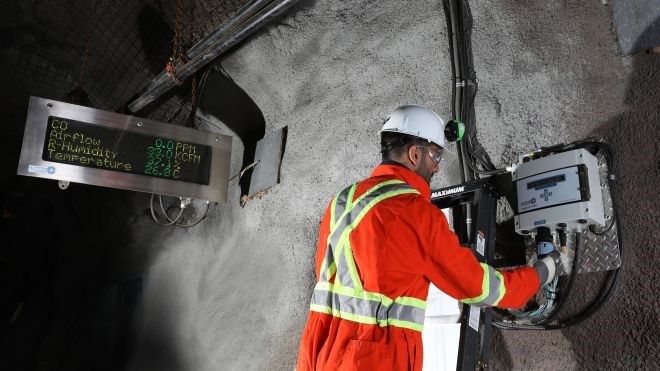What to do when technology no longer fits the needs of an ever-changing industry?
Reinvent it and bring it to the 21st century, of course.
It sounds like a no-brainer, but in the case of ultra-deep mining, technology once used on surface plants is being taken further underground and mining companies are discovering the negative effects, making them less reliable.
Ultra-deep mining presents many logistical and technical problems the current technology is not designed for. While mines are able to go deeper than ever before, there are many issues like worker heat stress, increasing temperature, barometric pressure and humidity which require higher cost ventilation monitoring and control systems. These ventilation systems are important to ensure the air underground is safe to breathe at all stages, from descent to the face.
To solve this problem, Maestro Digital Mine has designed an air quality monitoring station utilizing digital technology. Michael Gribbons, vice-president of sales and marketing, said they created the Vigilante AQS™ (Air Quality Station), after looking at the inadequacy of current analog-based systems. Similar to what VoIP (Voice over the Internet Protocol) telephones have done to transform the digital telephone industry, so too has the Vigilante AQS™ done to the underground mine ventilation sector.
“You will never be able to completely take humans out of mining, so ventilation will always be an issue that mines will have to address,” Gribbons said.
In addition to airflow rate and worker heat stress, the Vigilante AQS™ measures toxic gasses found in mines. The toxic gasses are generated from diesel equipment as well the strata gasses that are released from the liberated rock.
All of the sensors are fully digital and offer diagnostic functions in real time that can be read from surface.
“I use the candle in the wind analogy when speaking about our digital gas sensors,” said Gribbons.
The system was designed by David Ballantyne, vice-president of product development. The problem with previous stations was calibrating the gas sensors, he said.
“The existing technology required a specialist to go to each gas sensor and inject zero and span gas. However, the calibration gas was swept away due to the airflow at the installation location,” said Ballantyne.
“This resulted in inaccurate calibrations that would either force the miners away from the work area in safe conditions or, worse yet, allow miners into an area with unsafe gas levels.”
Rather than waste time with inaccurate or multiple calibrations, they eliminated that by creating a gas calibration station that remains on surface.
“The gas sensors are then rotated and calibrated on surface in a controlled environment. Once calibrated, the sensors can be exchanged under full power without the requirement of any tools and by anyone walking the beat.
“A specialist is not required, and this provides the mine with greater options to support the equipment internally,” he said.
The beauty of the station is not only does it measure environmental conditions, but it also monitors itself for breakdowns and malfunctions digitally, allowing for quick repairs and replacement of parts. All of this due to the fact that the system is digital.
The innovation isn't just in the method of calibration and diagnostic functions, but in the size, simplicity and cost advantage.
Before, Gribbons said, air quality stations were huge, had many components and weighed on average 200 pounds. The Vigilante AQS, which he said is designed on a “project to part number” ordering system, is much smaller, around 20 pounds, and is pretty much self-contained.
All the units are produced at their office in their Lively facility, just outside of Sudbury. They can be made to order quickly, he said, and can be installed by a single person and integrated in one day, again cutting down on costs, as well as space.
The components themselves are also easy to replace, due to all of them being on a part numbering system.
The system has proven to be very popular. Gribbons said it has been installed in 85 mines around the world. The quickest return on investment comes from blast clearance optimization, otherwise getting the miner back to the working face quicker and safer.
This can result in 30 minutes to two hours of additional production time in a drill and blast operation.
“That doesn't sound like a lot, but time is money,” he said. “It's an expensive industry and if the extra time can be used to advance the face and haul ore, the system can pay for itself in one or two shifts.”
These stations can be used to optimize energy as well, cutting down on mine costs. Gribbons said up to 40 to 60 per cent of a mine's energy consumption is based upon ventilation. The information from the system, he said, can be used to control auxiliary fans and regulators – shutters that control air and moisture flow – on each level.
Maestro was recently presented with Ultra-Deep Mining Network’s (UDMN) Outstanding Achievement in Commercialization award for a technical innovation, which ensures the safety of underground miners. The rapid commercial sale of this product to some of the deepest mines in the world is a testament that Maestro's efforts, combined with UDMN funding and guidance, can in fact bring technology faster to market which in turn benefits the mining industry and Canadians.




